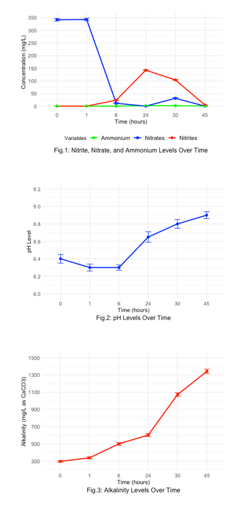EFFECT OF ANAEROBIC DENITRIFICATION IN Penaus vannamei PRODUCTION UNDER BIOFLOC SYSTEM
Introduction
Anaerobic denitrification consists of the microbial conversion of nitrate and nitrite into molecular nitrogen or nitrous oxide, promoting the removal of these compounds from aquatic environments. In aquaculture, this process improves water quality, prevents eutrophication, and reduces dependence on chemical inputs, thus promoting sustainability. This work aimed to test different strategies to optimize anaerobic denitrification in biofloc systems during the cultivation of Penaeus vannamei, evaluating different denitrification volumes and different concentrations of suspended solids.
Materials and methods
A preliminary three-week trial was conducted to assess the potential denitrification capacity of biofloc. Initially, biofloc was concentrated by decantation to levels of 3000 and 4000 mg/L and then exposed to water with a high nitrate concentration (approximately 305 mg N-NO₃/L). Since denitrification requires anaerobic conditions, molasses was added to achieve a carbon-to-nitrogen (C:N) ratio of 3:1. The pH was consistently maintained above 8.0 by adding a 1 M sodium hydroxide (NaOH) solution. Dissolved oxygen, temperature, and pH were monitored hourly for 12 hours during the denitrification process until stabilization. The process was considered complete when nitrate concentrations approached 0.0 mg/L. Chemical analysis of ammonia nitrogen (TAN) , nitrite (NO₂⁻, mg/L) , nitrate (NO₃⁻, mg/L) , phosphate levels (PO₄³⁻, mg/L), alkalinity (mg/L) were analyzed. To evaluate the impact of exchanging 25 % of denitrified water in Penaeus vannamei production under biofloc technology (BFT), six 350-L tanks stocked at a density of 150–200 shrimp/m² ( will be divided into two experimental groups: a control group and a denitrification group, with the latter receiving two weekly water exchanges of 20% of the tank volume using denitrified water.
Results
Along the progressive scaling o f denitrification tanks, the total nitrate was reduced to atmospheric N2 after 48 hours of denitrification process (Figure 1).
Key findings indicate that the higher concentration of suspended solids (4000 mg/L) exhibited nitrate removal efficiency comparable to the lower concentration (3000 mg/L), with minimal differences in stabilization parameters such as pH, DO, and alkalinity.
Discussion
In the present study, nitrate levels dropped from 341.845 mg/L to 0 mg/L within 48 hours, indicating complete removal. This aligns with Silva (2025), where denitrification occurred within 24 hours in treatments with 2000–2500 mg/L of suspended solids. However, our study required more time, reflecting system variations. The biofloc system effectively maintained low ammonia and nitrite levels while achieving nitrate removal.
Acknowledgments
This work was supported by I+D+i Research Project: “ Pursuing the zero waste in Biofloc Technology to produce a sustainable and biosafe aquaculture product (ZeroFloc)” (PID2023-149570OB-I00). J. Brol has a predoctoral grant from Generalitat Valenciana (Programa Santiago Grisolía 2021; CIGRIS/2021/109).
References
Silva, M. de F. G. (2025). Strategies for optimizing anaerobic denitrification during the cultivation of Penaeus vannamei in a biofloc system (Master’s dissertation , Federal University of Rio Grande).
